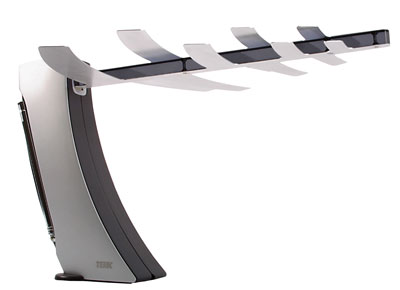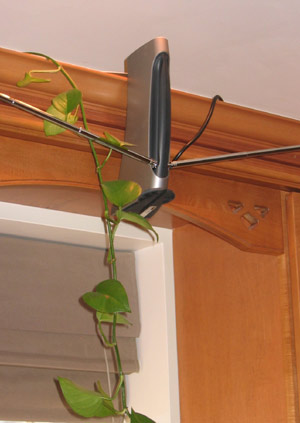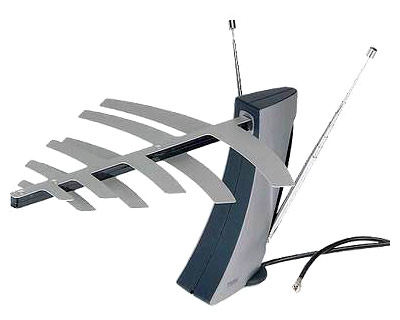Terk HDTVi VHF/UHF/HDTV Indoor Antenna by Audiovox Review
By Chris Boylan
Terk-ish Delight
It's a bit ironic, with the majority of TV viewers across the country and in other parts of the world now paying every month to watch TV via cable or satellite, but it turns out that some of the best quality HDTV broadcasts you can get won't cost you a dime. As more people are discovering every day, those old antennas on roofs and in attics across this land of ours are ideal for snatching high quality digital HDTV and SDTV signals right out of the air. NBC, ABC, Fox, CBS, UPN, PBS, Qubo, The Tube - just a sampling of the channels that are currently being broadcast digitally over the air in major (and minor) cities all over the country.
Yes, the lowly over-the-air antenna is making a comeback. Of course, in order to take advantage of all this great free content, you'll need an HDTV with a built-in ATSC tuner, or an external tuner of the same type. And an antenna isn't going to get you "pay" channels such as HBO, STARZ or Discovery-HD - these are only available via paid services such as cable, Fios or satellite. Also, there are many areas of the country that are just too far from HDTV broadcast towers to get a usable signal (check
Antenna Web to see if there are towers near you). But for those close enough to the broadcast towers, there can be a wealth of free digital content at your fingertips, if only you have the means to receive them.

Terk's HDTVi UHF/VHF/HDTV Indoor Antenna
Ideally, you'll want to put an antenna outside, as high as possible, where it can hopefully get an unobstructed view of nearby broadcast towers. But if you're in an apartment, or your coop or condo board won't approve visible outdoor antennas, then there are always indoor antennas that may be able to get you by. One of these is the subject of this review, the
Terk HDTVi UHF/VHF/HDTV antenna.
When an odd grounding problem caused our outdoor roof antenna to become unusable, and a quick fix wasn't forthcoming, I explored my options for a temporary indoor replacement. Our current A/V system currently has no less than six separate devices (HD DVR, DVD recorders, VCR, etc.) which rely on a decent quality antenna signal, so I was motivated to find something that would get the job done, without being too invasive or unsightly. The Terk HDTVi looked promising so I took one home and put it to the test.
An HDTV antenna really isn't all that special, or different from the antennae of yesteryear. In fact, HDTV signals are broadcast over the old UHF band, so any good UHF antenna should be able to pick up HDTV signals, if they're strong enough. And in terms of antenna design, in many cases simpler is better. There are many "powered" indoor antenna options available, usually more expensive than their passive brethren. Generally speaking, however, the amplifiers built into indoor antennas are not very effective. They amplify the noise as well as the signal, so they may not actually improve reception in fringe areas. You're usually better off starting with a passive antenna (like the Terk HDTVi), then adding a decent quality amplifier if necessary, such as one of the ones mentioned in a recent "
Ask The Expert" article.
The HDTVi antenna is one of the less expensive options available (less than $30) and it actually serves dual duty as both a VHF and UHF/HDTV antenna. This is useful if you want to use the antenna with current DVD recorders, VCRs and TVs that have standard NTSC tuners. If all goes to plan, analog VHF TV broadcasts will be completely offline by February 2009, but until then it's nice to be able to accommodate both current and future technology. If you want to use the HDTVi for VHF reception then you'll probably have to extend the "rabbit ears" at the back of the antenna and try to place these at right angles to the line of broadcast (perpendicular to an imaginary line you draw between the broadcast tower and your house).

Cleverly disguised among the hanging vines, the HDTVi blends right in.
In my testing, I found that the HDTVi's reception got noticeably stronger the closer it was placed to the exterior wall and window. Also, as it is directional, relatively small changes in orientation of the antenna could make the difference between success or failure in channel reception. With digital signals, you're generally going to either get it or not. If you're above the reception threshold where the tuner can piece together the digital signal, then it will look virtually perfect. If you fall below that threshold then you'll generally either lose the signal entirely or get a really distorted image with blocking, drop-outs and pixilation throughout the signal. This differs from VHF and analog UHF reception where you may get a fuzzy, but still watchable signal if reception is not ideal.
It didn't take long to find a good spot for the antenna, for both reception and aesthetic purposes, and I admit it is probably not the most traditional placement. Our antenna is currently hanging by its UHF elements from the top of our kitchen cabinets with the rabbit ears spread out horizontally. It may sound odd, but when my mother came for a visit, she was there three days without noticing it was there. This means the UHF elements actually have a brick wall between them and the broadcast tower, but we are very close to the broadcast antenna (less than a mile) so this barrier was not enough to impede a strong UHF signal.
Without amplification, the signal from the HDTVi was able to provide glitch-free reception of all of our local digital and analog channels to any one device (HD DVR, DVD recorder, VCR, etc.) but the signal was not strong enough to be split among multiple devices. However, I was able to amplify and split the signal eight ways using a Channel Master amplifier/splitter and the quality of digital channel reception was not significantly worse. So, even split 8 ways (with a decent amplifier), I was able to get a strong enough digital signal to receive all of the local HD and SD digital channels. analog VHF reception did lose a bit of quality when split this many times, but this is to be expected from such a simple antenna that is not ideally placed.

The Terk HDTVi can receive both analog and digital broadcasts.
Most outdoor antennas have multiple crossbars or elements (for both UHF and VHF reception). The lengths and orientation of these elements are actually critical in getting the best reception. The UHF portion of the HDTVi follows this design, with multiple horizontal elements of varying lengths. This allows the antenna to do particularly well receiving UHF/HDTV signals. But the VHF rabbit ears are effectively one single element so no matter what you do, some VHF channels will come in better than others, depending on antenna orientation and the length to which you extended the elements. For the best overall reception, I ended up with the VHF antenna extended about two thirds of the way with the elements angled just slightly toward the transmission towers. This gave me the best overall reception for VHF, and, as mentioned above, digital reception was just peachy.
Final Thoughts
If you're close to local broadcast towers, or are a few miles away with a clear shot, it's worth the $20-$30 (street price) it will cost you for the Terk HDTVi, just to see if you can get your local HD on for free. For those with cable or satellite service, if you find yourself with some but not all of your local affiliate channels coming in High Def, an antenna may be a great way to tune in what the cable or satellite provider left out. For us, with DISH Network, we were able to pick up a few local affiliate channels in HD that DISH does not provide (including PBS-HD, a staple of our household) using the Terk HDTVi. It won't work miracles, but it did the job for us. Highly recommended.
Where to Buy:Manufacturer's Contact Details:
Audiovox, Inc.
180 Marcus Boulevard
Hauppauge, New York 11788
Customer Service Phone: 1-800-645-4994
General Phone: 1-631-231-7750
Local Customer Service Phone: 1-631-231-6051
General Fax: 1-631-434-3995
Web Site:
www.audiovox.com


